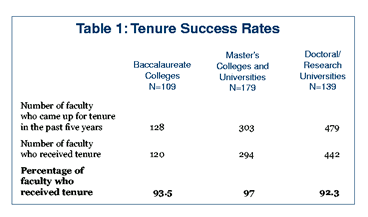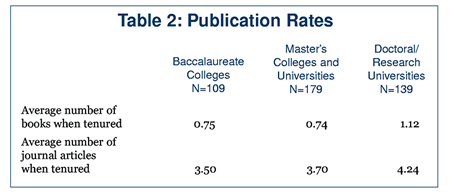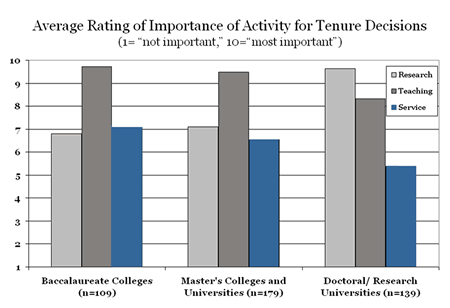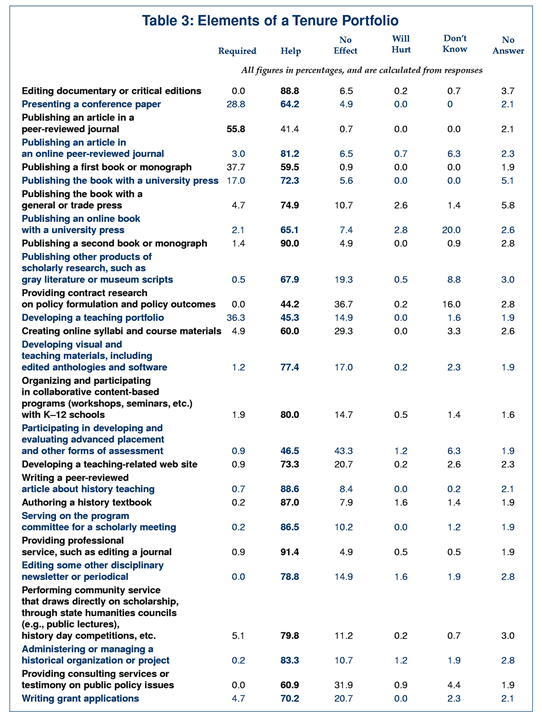News
A Survey of Tenure Practices in History: Departments Indicate Books Are Key and Success Rates for Tenure High
A survey conducted in the fall of 2003 by the AHA's Research Division reveals that most history departments and programs expect faculty members coming up for tenure review to have published one or more books. While this is hardly surprising at research universities (where a published book is typically an institutional requirement), the survey findings indicate that similar expectations are held by departments and programs at almost every type of four-year college and university.
The survey also indicated that almost everyone who comes up for tenure ultimately receives it. According to all the respondents, more than 94 percent of the faculty who came up for tenure over the past five years received it.
While this tells us nothing about the situation for the large (and growing) number of historians employed off the tenure track, the survey evidence brings some clarity to issues that are too often the subject of speculation. The survey responses validate anecdotal perceptions that the monograph is a general requirement for tenure in the profession. It also called into question concerns about the difficulties involved in getting published, and undermined the common notion that the failure rate for securing tenure was high.
The Responses
The response to the survey was rather mixed. In an effort to be comprehensive, we used a larger-than-usual mailing list, comprising 1,223 institutions where we could identify more than two faculty in the field. Unfortunately, since this included a large number of institutions without discrete history departments, it produced a relatively modest response from smaller programs.1
Still, 441 programs did respond. Departments at doctoral and research universities provided an exceptionally high response, with more than 60 percent getting back to us. Only about one-third of the departments at master's and baccalaureate colleges and universities responded, but still enough to provide statistically useful information. Regrettably, very few two-year and specialized institutions responded and could not be included.2
Who Gives/Who Gets Tenure
To develop a baseline of information, we asked the departments how many faculty came up for tenure, how many of those faculty received tenure, and how many publications they had at tenure.
Most of the responding programs (77 percent) reported that at least one faculty member had come up for tenure at their program over the past five years. Institutions with tenure reported that 910 faculty came up for tenure, and 856 received tenure—a 94 percent success rate (see Table 1).

When compared to the most recent institution-level survey by the U.S. Department of Education, these rates seem exceptionally high. In their most recent survey, covering the 1997-98 academic year, colleges and universities reported that only 81 percent of those considered for tenure (in all fields) ultimately received it.3 It is unclear whether this reflects a disparity between history and other fields, a difference in the universe of programs surveyed (particularly the absence of two-year programs in our results), or a difference in perception among those doing the counting.
Nevertheless, the results were surprisingly uniform across the range of institutions that responded to our survey. Tenure rates at doctoral/research institutions and in programs conferring the PhD were only slightly below the average, as 92.3 percent of those eligible succeeded in securing tenure.
The only significant variation appeared when we broke the results down by region, as programs in the Midwest (accounting for a quarter of the faculty who came up for tenure) reported a 98.3 percent success rate. The other regions were all very close to the average.
Projections of a Large Increase in Faculty Seeking Tenure
Given the large increases in hiring over the past eight years, it is hardly surprising that the departments project sizeable increases in the number of faculty coming up for tenure. Looking ahead at the next five years, the chairs estimated a 31 percent increase—1,203 faculty at the responding institutions, as compared to 910 faculty who came up for tenure over the past five years.
Programs that confer the PhD and departments at institutions classified as doctoral/research universities projected the smallest amount of growth. PhD-granting departments projected increases of only 13 percent, while programs at doctoral/research universities only projected increases of 21 percent. This compares to increases of more than 44 percent at other types of institutions. This is somewhat deceptive, however, as our surveys of hiring patterns at departments listed in the Directory indicate that PhD-granting history departments are more likely to hire mid- to senior-level faculty into tenured posts.
Viewed regionally, the projected increases in faculty coming up for tenure tend to align with hiring patterns over the past decade, with the largest amount of growth (a 51 percent increase) projected at programs in the West. Programs in the Southeast anticipated the least amount of growth, at just 20 percent.
Publication Rates
Overall, faculty who received tenure had an average of one book (in print or in press) and three journal articles (in print) to their credit, but these figures also varied by the type of institution (see Table 2).

Faculty at history departments in doctoral and research universities had at least one book at tenure (the average was 1.12 books at tenure). Among faculty at baccalaureate- and master's-degree granting institutions only about 3 in every 4 faculty had published a book. The relatively high publication rates, even at institutions focused on teaching, reinforce the perception that the history field relies heavily on the book as a key criterion for tenure (see related information from the Committee on Institutional Cooperation in the article, "Is History Falling Behind the Times?" on pages 11-12 of this issue).
When viewed alongside the relatively high rates of tenure, these publication rates seem to reinforce evidence that the widely discussed problems of scholarly publishing are not yet impinging on the field of history. But the reliance on books for tenure decisions also suggests that history would be strongly affected if it became much harder to publish scholarly monographs.4
There was a similar pattern in the average number of journal articles published at tenure. Faculty in doctoral programs had published an average of 4.25 journal articles, while faculty in baccalaureate programs had published an average of 3.5 articles at tenure.
Differing Priorities
In addition to the quantitative questions, we also asked a series of qualitative questions about the programs' criteria for tenure. Asked to rate the importance of research, teaching, and service, our survey revealed pronounced differences among the programs. Not surprisingly, research is the top priority at doctoral and research institutions, and teaching is the top priority at all other programs. On a 1 to 10 scale, (with 1 indicating "not important" and 10 designating "most important") research received an average rating of 9.64 at doctoral/research programs, as compared to a 6.81 rating in baccalaureate institutions and 7.09 rating in master's institutions. Only doctoral programs gave a clear priority to research over teaching. The other programs all rated teaching much higher as a criterion in determining tenure decisions at or above 9.5, as compared to 8.33 at the doctoral/research programs (see Figure 1).

There was a modest difference between private and public institutions on this point as well, as private institutions (with a large proportion of liberal arts colleges) gave a 7.22 average rating for research, as compared to an 8.16 rating at public colleges and universities. Service work (departmental committees, administrative duties, and the like) rates well below teaching in all programs. It is given almost half the value of research at the doctoral programs, and rates below research in master's institutions. It is only at baccalaureate colleges that service averages slightly higher than research.
Criteria for Tenure
To provide more specific details on these priorities, we asked respondents about the practical advice they might give a junior colleague on some of the specific elements of a tenure portfolio (see Table 3).

The standard response was to say it would "help." But a few department chairs appended (or sent) comments observing that this was both obvious and conditional. The activity would help, as long as it did not get in the way of the "real" priorities of the department or institution—often finishing the monograph, although teaching was mentioned in two instances. Hugh West, chair of the department of the University of Richmond, perhaps captured these sentiments best, with the observation that, "my answer to virtually every question was, 'it depends.' Each case is too individual to break down in this way. Not all documentary or critical editions are equal; some have room for them, others don't—and so on." In keeping with that, the results are heavily skewed toward "help" column.
However, there is still some intriguing evidence to be found where significant numbers of respondents deviated from the "help" column. Perhaps most interesting is the seemingly small number of programs—just 37.7 percent—that "require" a published book or monograph. This stands in marked contrast to the actual practice evidenced in the books published at tenure. However, an admittedly unscientific review of tenure policies submitted by 8 percent of the programs indicates that this tends to mark a difference between university-level requirements and the expectations of the department.
There was a vast gulf between programs on this question. There was a book requirement at 94 percent of the departments that confer the PhD, as compared to 18 percent of the programs that only confer bachelor's degrees, and 24 percent of the programs where the MA is the highest degree.
Perhaps more surprising was the fact that a slightly larger number of programs reported that they require a teaching portfolio than the number that require a monograph. But the doctoral institutions led the way in this requirement as well, as 46 percent of the departments in doctoral colleges and universities reported this requirement. In comparison, only 30 percent of the baccalaureate colleges had the requirement, and 32 percent of the master's institutions. Very few departments marked off responses as specifically harmful to the chances of tenure. Publishing an online book—even with a university press—was marked out as detrimental at 2.8 percent of the institutions. This just edged out publishing with a trade press. The ambivalence on this question was reinforced by the exceptionally large number of department chairs (20 percent) who said they did not know how it would affect someone's chances for tenure. Publishing with a commercial press seemed to generate a similar level of hostility, but not the ambivalence.
Beyond these, only teaching-related activities seemed to generate even a modest amount of negative attention. Perhaps most notably, 1.6 percent of the programs singled out authoring a textbook as something that would hurt one's chances for tenure.
—Robert B. Townsend is assistant director for research and publications at the American Historical Association.
The survey instrument was prepared under the direction of the AHA's Research Division, with advice and guidance from Gabrielle Spiegel, Noel Stowe, and Chris Golde. Directory Editor Liz Townsend assisted in the tabulation of data, and Roy Rosenzweig, Mériam Belli, and Elizabeth Fairhead offered advice and comments on this report.
Notes
1. The mailing list was developed using the Department of Education's College Opportunities Online database of institutions that confer degrees in the "Social Sciences and History" (online at http://nces.ed.gov/ipeds/cool/). Staff then surveyed the web sites of all institutions that do not list in the AHA's Directory of History Departments, Historical Organizations, and Historians for faculty teaching in the field of history. Where a discrete history department or more than two faculty teaching in history were located, the institution was added to the mailing list. Results were cross tabulated by Carnegie classification and control of the responding institution, the region in which the college or university resides (using the categories employed in the Employment Information section), and the highest degree conferred by the department or program.
2. Among the responding departments, four reported that they lack tenure (all were small private religious colleges). However, the actual number of programs without tenure among those to whom the survey was sent is undoubtedly much higher. According to the Department of Education, one-third of all institutions lack tenure systems. See Andrea Berger, Rita Kirshstein, Elizabeth Rowe, Institutional Policies and Practices: Findings from the 1999 National Study of Postsecondary Faculty, Institution Survey (Washington, D.C.: U.S. Department of Education, National Center for Education Statistics, 2001). In addition to the problem of finding departmental staffs or program chairs to respond to our survey, a small number of departments (8) at a variety of institutions declined to answer the survey because of objections to the some of the questions.
3. Berger, et al., Institutional Policies and Practices, 32.
4. For more on this issue, see Robert B. Townsend, "History and the Future of Scholarly Publishing," Perspectives (October 2003), 32.
Tags: Tenure & Promotion
Comment
Please read our commenting and letters policy before submitting.






